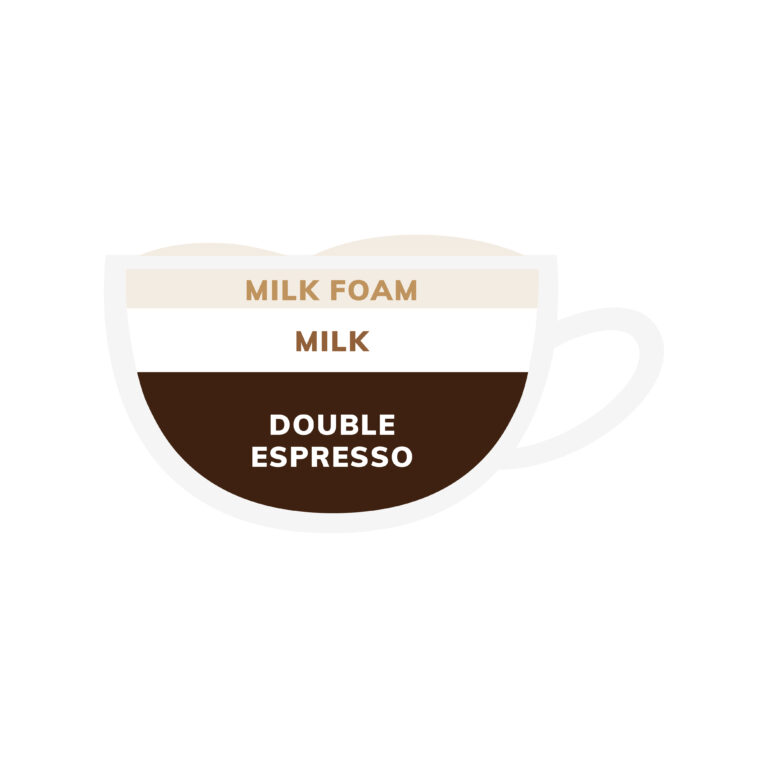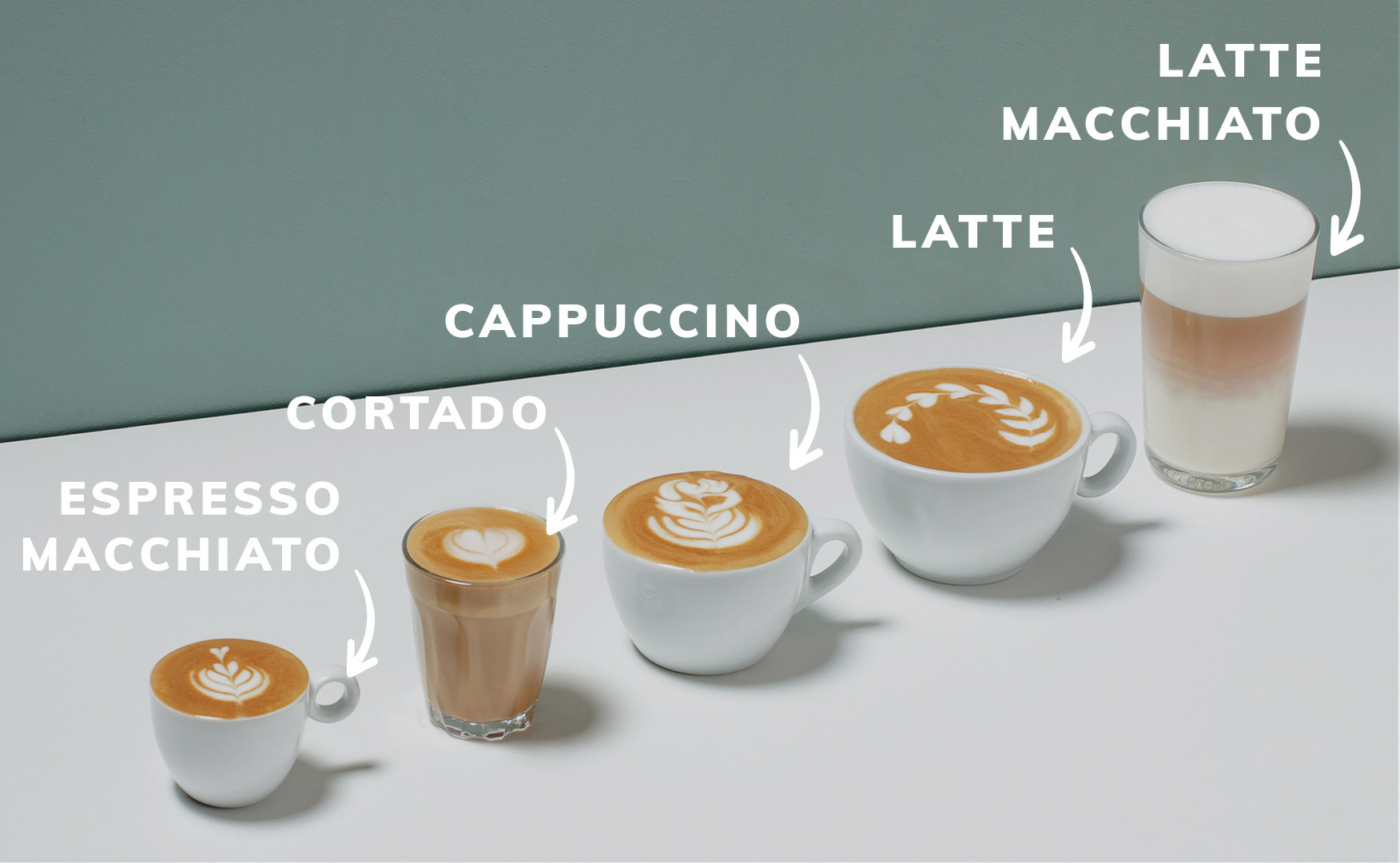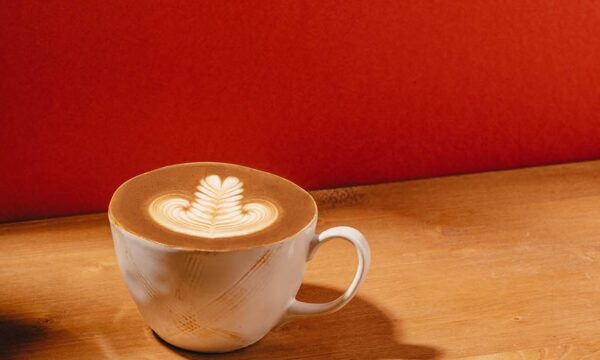
- Home
- The Different Types of Coffee

The Different Types of Coffee
Written by Julie
Espresso, flat white, latte macchiato… Do you have trouble understanding the different types of coffee? We’ll explain it all! Recipes can change depending on the country and taste. But here’s a practical semi-universal guide that broadly outlines the most popular caffeinated drinks.
The Different Types of Coffee Explained
Arabica Coffee
Arabica is one of the most cultivated and consumed types of coffee. It’s a richly-flavoured, yet delicate coffee. It is low in caffeine and gets its name from the Arabian peninsula.
Robusta Coffee
Robusta coffee, like Arabica coffee, comes from Africa. Robusta coffee has a flavour that is more full-bodied and bitter than arabica: all the bitterness of the coffee is in the cup. It’s also has a higher caffeine content than arabica.
The Key Coffees
When it comes to coffee there’s something for everyone. But there are always a few key types: those that everyone agrees on and are on almost every menu.

Espresso – what’s inside: 30ml of espresso
It’s the best-known coffee. Also called “express”, “expresso” or a short coffee, it’s a very full-bodied coffee with a strong flavour.
It’s made using a high-pressure filter, i.e. by quickly passing hot water under 9 bars of pressure through finely ground and roasted coffee.
Everything is a matter of taste when it comes to coffee: arabica and robusta are both suitable. But if you want a more traditional espresso, choose a dark roast robusta.

Ristretto – what’s inside: 22ml of espresso
A ristretto is a short espresso, and is sometimes called a “café serré” (tight coffee) in France. It’s a more concentrated and darker version of espresso.
A Caffè Ristretto is made using the same amount of coffee as an espresso but with half the amount of water.
If you want to have a ristretto like they do in Italy, then robusta is the best choice.

Double espresso – what’s inside: 60ml of espresso
From the Italian doppio (“double” in English), the double espresso is a very concentrated drink and has a more pronounced flavour than an espresso.
To make it you need a double shot of espresso, which will be extracted using double the amount of ground coffee in a large portafilter basket. No water is added during preparation.
Once again you can use arabica or robusta according to desire and taste preferences.
Milky Coffees
These are all coffee-based milk drinks. The difference between these coffees lies in the coffee to milk ratio as well as the texture of the milk and the concentration of coffee.

Cappuccino – what’s inside: 60ml of espresso, 120ml of milk
Created in Italy, the cappuccino is a coffee-based drink made with espresso, hot milk and steamed milk froth.
A cappuccino differs from a caffè latte in that it’s made with a lot less steamed or textured milk than a caffè latte. The total amount of espresso and milk/foam is around 150 to 180 ml. It is prepared by covering an espresso base with hot milk and a thick layer of milk foam.
Robusta is the perfect choice for a good cappuccino.

Latte Macchiato – what’s inside: 340ml of milk and 30 ml of espresso
The latte macchiato is made of several elements: milk, milk foam and espresso. It’s a very popular coffee in coffee shops around the world: it combines the natural “sweetness” of milk with the character of the coffee.
The quantities can vary, but this drink is typically served in a clear glass (preferably double-walled), in order to show off the layers. We suggest using fresh whole milk for the milk foam.
Don’t hesitate to use robusta coffee for a latte macchiato. This will nicely counter the taste of the milk.

Mocaccino – what’s inside: 15ml of hot chocolate, 30 ml of espresso and 145 ml of milk
The mocaccino, also called a “mochaccino” or even “mokaccino”, is a drink made with cappuccino, cream and hot chocolate and comes from the US. It’s a great option if you can’t choose between a coffee and a hot chocolate.
But what makes it different from a cappuccino? A mocaccino contains more milk foam and, of course, hot chocolate.
Robusta, with its less developed and more irregular flavour, is the ideal choice for a mocaccino.

Flat white – what’s inside: 60ml of espresso and 120 ml of steamed milk
A flat white is an espresso with a coffee to milk ratio similar to a latte and a cappuccino. The main difference is the texture of the milk and (in certain regions) the number of shots of espresso. A flat white will be stronger in flavour than these other two drinks.
Prepare an espresso and then add the milk. The milk is prepared by running steam through the milk and folding in the top layer.
Once again, a caffeinated milky drink means that robusta is the better choice over arabica.

Espresso Macchiato – what’s inside: 30ml of espresso and 20 ml of milk
Created in Italy the espresso macchiato, or caffè macchiato, is an espresso topped with a small amount of milk and milk foam, similar to a cappuccino, but with a stronger flavour. The Italian word macchiato is a reference to the mark the milk makes on the surface of the coffee: hence it’s “marked”.
You prepare it by taking an espresso base and adding a spoonful of steamed milk and milk foam.
The espresso macchiato is made using robusta, which is ideal for caffeinated milky drinks.
Coffees From Around the World
Sometimes you have to update the menu. And what’s better than caffeinated drinks from around the world? Each more original than the last, they will allow you to reinvent your favourite drink.

Americano – what’s inside: 25ml of espresso and 125 ml of hot water
Inherited from the Second World War, the americano, or American coffee, comes from the US. It’s distinguished by its double espresso and is made using espresso and hot water. It’s a less strong coffee, making it great for breakfast. It’s a very popular drink!
It’s made by filling a cup with hot water and adding in the aforementioned amount of espresso.
Choose arabica when making your americano as its flavour is richer.

Viennese coffee – what’s inside: 60ml of espresso and 60 ml of steamed milk or cream
As its name suggests, the Viennese coffee (not to be confused with the “Vienna roast” coffee) originated in Austria. It’s a coffee or espresso topped with whipped cream.
Milk is sometimes poured into the espresso before adding the whipped cream. Vanilla, chocolate or cinnamon powder can also be sprinkled over the cream. Generally, Viennese coffee has an espresso base and whipped cream is added on top.
Both arabica and robusta could be suitable for this type of coffee. Its special feature is the cream.

Irish Coffee – what’s inside: 100 ml of espresso, 40ml of whiskey and 40 of fresh cream
An Irish coffee is a combination of whiskey and cream. It was created in Ireland during the Second World War.
It’s made using filtered coffee, brown sugar, whiskey (preferably an Irish whiskey) and cream. You can also add toppings: this coffee can have many variations according to preference!
For this very particular coffee, you can use either arabica or robusta according to taste.

Affogato – what’s inside: 60ml of espresso and 90 ml of vanilla ice cream (1 scoop)
It’s more than just a coffee, it’s also a traditional Italian desert that combines coffee and ice cream.
The affogato or affogato al caffè, is made by pouring espresso over a vanilla ice cream base. Once again, there are many different versions: you can add liqueurs, cocoa powder, Chantilly cream or other toppings.
Both arabica and robusta are suitable.

Iced Coffee – what’s inside: 60ml of espresso, water as needed for the desired flavour and/or ice
An iced coffee is a variant of the affogato, or even the coffee sundae (café liégeois). It’s a caffeinated drink with a cold or hot coffee base that is served with ice. It comes from the US.
There are many different ways to prepare it. You can prepare an espresso and add in ice cubes, or pour cold water into the espresso and leave to steep for several hours.
Choose a robusta because its stronger flavour won’t get lost when you add ice cubes or water.
You now know everything you need to choose your drink the next time you visit your favourite coffee shop. With these different types of coffee you can let yourself by surprised by a variety of flavours and textures. The coffee universe is huge and full of novelties: now it’s up to you to find your perfect coffee!
Discover all of our articles





